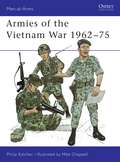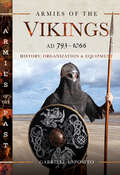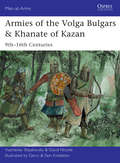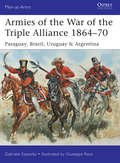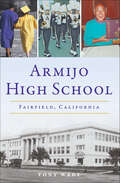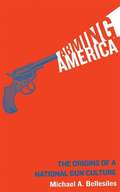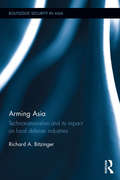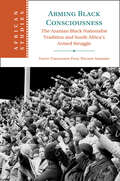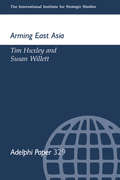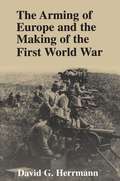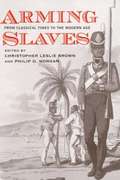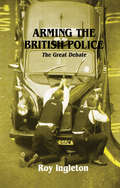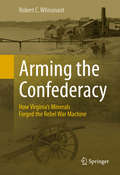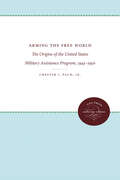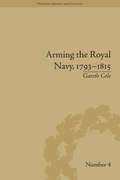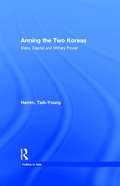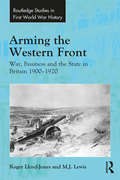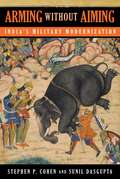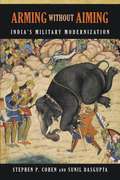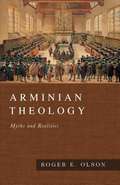- Table View
- List View
Armies of the Vietnam War 1962-75
by Mike Chappell Philip KatcherPhilip Katcher provides an overview to the conflict that engulfed Vietnam following the division of the country into two along the 17th Parallel in 1954. The uniforms and insignia of the US forces, including the army, Special Forces, air force, navy and marine corps, are dealt with in detail, together with those of the ARVN, the Allied Forces (such as the Royal Thai Army and Korean troops), and also the Communist NLF (Viet Cong) and NVA forces. Mike Chappell's colourful artwork provides plenty of detail to accompany this authoritative text.
Armies of the Vikings, AD 793–1066: History, Organization and Equipment (Armies of the Past)
by Gabriele EspositoViking warriors were feared by their contemporaries and their ferocious reputation has survived down to the present day. This book covers the military history of the Vikings from their early raiding to the final failure of their expansionist ambitions directed against England. In that period Viking warbands and increasingly large armies had left their Scandinavian homelands to range across vast regions, including the whole of Northern Europe and beyond, even reaching North America. The British Isles were terrorized for two centuries and at times largely conquered, in Normandy, Russia and elsewhere they also settled and founded states. Tough, skilled and resourceful, with a culture that embraced the pursuit of immortal fame and a heroic death in battle, their renown as warriors was second to none. As far afield as Constantinople, the Byzantine emperors employed them as their elite Varangian Guard. Gabriele Esposito outlines the history of their campaigns and battles and examines in detail their strategy, tactics, weapons, armour and clothing. The subject is brought to life by dozens of color photographs of replica equipment in use.
Armies of the Volga Bulgars & Khanate of Kazan
by Viacheslav Shpakovsky Gerry EmbletonFacing off against Byzantines, Arabs, Vikings, Turks, Mongols, and Russians, this steppe culture dominated Black Sea and Caucasus trade during Medieval times.The Bulgars were a Turkic people who established a state north of the Black Sea, and who showed similarities with the Alans and Sarmatians. In the late 500s and early 600s AD their state fragmented under pressure from the Khazars; one group moved south into what became Bulgaria, but the rest moved north during the 7th and 8th centuries to the basin of the Volga river. There they remained under Khazar domination until the Khazar Khanate was defeated by Kievan (Scandinavian) Russia in 965. Thereafter the Volga Bulgars - controlling an extensive area surrounding an important hub of international trade - became richer and more influential; they embraced Islam, becoming the most northerly of medieval peoples to do so. Given their central position on trade routes, their armies were noted for the splendour of their armour and weapons, which drew upon both Western and Eastern sources and influences (as, eventually, did their fighting tactics).In the 1220s they managed to maul Genghis Khan's Mongols, who returned to devastate their towns in revenge. By the 1350s they had recovered much of their wealth, but they were caught in the middle between the Tatar Golden Horde and the Christian Russian principalities. They were ravaged by these two armies in turn on several occasions between 1360 and 1431. A new city then rose from the ashes - Kazan, originally called New Bulgar - and the successor Islamic Khanate of Kazan resisted the Russians until falling to Ivan the Terrible in 1552. The costumes, armament, armour and fighting methods of the Volga Bulgars during this momentous period are explored in this fully illustrated study.
Armies of the War of the Pacific 1879-83
by Gabriele EspositoThe Pacific War was the climax of the decades-long Wars of Liberation, and is one of the most important conflicts in South American history. After winning their independence from Spain in 1825, Peru and Bolivia became separate nations - but over the following years repeated attempts to re-unite them were frustrated by the neighboring powers, particularly Chile. By the 1870s Chilean military superiority and expansionist policies exploded into full scale conflict. This book examines the troops, uniforms and equipment used by forces on all three sides of the conflict and traces the events of the war from the early naval blockades to the full-scale amphibious landings undertaken by the Chilean forces. The war ended in total victory for Chile, and that country's emergence thereafter as 'the Prussia of South America', while it cost Peru a lucrative province, and Bolivia its outlet to the Pacific coast.
Armies of the War of the Triple Alliance 1864-70
by Giuseppe Rava Gabriele EspositoBetween 1864 and 1870 four nations fought in an extraordinarily bloody war - the largest in the history of South America. The powerhouses Argentina and Brazil alongside tiny Uruguay on one side, and the small but increasingly-powerful Paraguay on the other, fought a conflict that was almost contemporary with the American Civil War and Franco-Prussian War, and rivalled their very high casualty rates. The aftermath of the war saw defeated Paraguay's territory diminished, its total population reduced by a staggering 70 per cent, and its economy ruined for generations, while victorious Brazil was established as the predominant military power on the continent. Despite the extraordinary ferocity of the fighting and the significant historical consequences thereafter, little has been published in English on a war that shaped the political map of Latin America to this day. This title book in some crucial gaps by telling the story of the men who fought on both sides, using contemporary paintings, prints, and rare early photographs combined with detailed research and engaging analysis.
Armijo High School: Fairfield, California (Landmarks)
by Tony WadeOver a century of history, pride and tradition. Armijo High School opened its doors for the first time in 1891. What began in the upstairs classrooms of Crystal Elementary School in Suisun City grew to the sprawling campus on Washington Street in order to serve the rising population of Fairfield, California. Armijo alumni have made indelible marks in numerous fields, including medicine, law, civil and military service, athletics, and the arts. Notable graduates include Noriyuki "Pat" Morita who earned an Academy Award nomination for playing Mr. Miyagi in The Karate Kid movies, New York Giants Super Bowl champion George Martin and Johnny Colla, multi-platinum recording artist with Huey Lewis and the News. Join Tony Wade as he delves into the generations of students, parents and faculty that embody Armijo pride.
Arming America: The Origins of a National Gun Culture
by Michael A. BellesilesBellesiles (history, Emory U. ) explodes a number of myths about the role of guns in American history. Examining probate records, correspondence of militia commanders, and a number of other sources he finds that gun ownership among average Americans wasn't widespread until as late as the Civil War. He also argues that from the very beginning of European settlement, guns were highly regulated by authorities and that guns were viewed as having a special status as being ultimately at the disposal of government.
Arming and Disarming
by R. Blake BrownFrom the École Polytechnique shootings of 1989 to the political controversy surrounding the elimination of the federal long-gun registry, the issue of gun control has been a subject of fierce debate in Canada. But in fact, firearm regulation has been a sharply contested issue in the country since Confederation. Arming and Disarming offers the first comprehensive history of gun control in Canada from the colonial period to the present.In this sweeping, immersive book, R. Blake Brown outlines efforts to regulate the use of guns by young people, punish the misuse of arms, impose licensing regimes, and create firearm registries. Brown also challenges many popular assumptions about Canadian history, suggesting that gun ownership was far from universal during much of the colonial period, and that many nineteenth century lawyers - including John A. Macdonald - believed in a limited right to bear arms.Arming and Disarming provides a careful exploration of how social, economic, cultural, legal, and constitutional concerns shaped gun legislation and its implementation, as well as how these factors defined Canada's historical and contemporary 'gun culture.'
Arming Asia: Technonationalism and its Impact on Local Defense Industries (Routledge Security in Asia Series)
by Richard BitzingerBitzinger examines the phenomenon of attempted self-reliance in arms production within Asia, and assesses the extent of success in balancing this independence with the growing requirements of next-generation weapons systems. He analyzes China, India, Japan, South Korea, and Southeast Asia. The overarching question in the book is whether self-reliance is a strategically viable solution for development and manufacturing of arms. Given the ever-changing dynamics and increasing demand for sophisticated next-generation weaponry, will these countries be able to individually sustain their domestic defense industries and constantly update their technologies? This is the first book to analyze arms production from a regional perspective.
Arming Black Consciousness: The Azanian Black Nationalist Tradition and South Africa's Armed Struggle (African Studies #164)
by Toivo Tukongeni AsheekeSince 1994, as the ruling party in South Africa, the ANC have become synonymous with and indivisible from the fight against apartheid rule. This has left little space for competing accounts, visions, and political projects to find their appropriate place in the historical narrative. In this innovative book, Toivo Asheeke moves beyond these well-trodden histories, to tell the previously neglected story of the Black Consciousness Movement (BCM), a militant revolutionary nationalist wing of the anti-colonial struggle. Using archival sources from four countries and interviews with former veterans of the movement, Asheeke explores the BCM's engagement with guerrilla warfare, community feminism and Black Internationalism. Uncovering the personal and political histories of those who have previously received scant scholarly attention, Asheeke both illuminates the history of Africa's decolonization struggle and that of the wider Cold War.
Arming East Russia (Adelphi series)
by Tim Huxley Susan WillettDuring the 1990s, military spending, arms procurement and defence industrialisation have all increased rapidly in East Asia. Although these developments do not constitute an arms race, they nevertheless have important implications for suppliers of defence equipment, for arms control and for regional stability. This paper assesses trends in the defence spending of East Asian states, particularly in the light of the economic crisis, which began in mid-1997. It also focuses on three closely-related issues: the nature of the regional market for defence equipment; defence industrialisation; and the effect of trends in defence procurement and industrialisation on East Asian states' military capabilities, and on the regional military balance.
The Arming of Europe and the Making of the First World War (Princeton Studies In International History And Politics)
by David G. HerrmannDavid Herrmann's work is the most complete study to date of how land-based military power influenced international affairs during the series of diplomatic crises that led up to the First World War. Instead of emphasizing the naval arms race, which has been extensively studied before, Herrmann draws on documentary research in military and state archives in Germany, France, Austria, England, and Italy to show the previously unexplored effects of changes in the strength of the European armies during this period. Herrmann's work provides not only a contribution to debates about the causes of the war but also an account of how the European armies adopted the new weaponry of the twentieth century in the decade before 1914, including quick-firing artillery, machine guns, motor transport, and aircraft. In a narrative account that runs from the beginning of a series of international crises in 1904 until the outbreak of the war, Herrmann points to changes in the balance of military power to explain why the war began in 1914, instead of at some other time. Russia was incapable of waging a European war in the aftermath of its defeat at the hands of Japan in 1904-5, but in 1912, when Russia appeared to be regaining its capacity to fight, an unprecedented land-armaments race began. Consequently, when the July crisis of 1914 developed, the atmosphere of military competition made war a far more likely outcome than it would have been a decade earlier.
Arming Slaves: From Classical Times to the Modern Age
by Christopher Leslie Brown Philip D. MorganArming slaves as soldiers is a counterintuitive idea. Yet throughout history, in many varied societies, slaveholders have entrusted slaves with the use of deadly force. This book is the first to survey the practice broadly across space and time, encompassing the cultures of classical Greece, the early Islamic kingdoms of the Near East, West and East Africa, the British and French Caribbean, the United States, and Latin America. To facilitate cross-cultural comparisons, each chapter addresses four crucial issues: the social and cultural facts regarding the arming of slaves, the experience of slave soldiers, the ideological origins and consequences of equipping enslaved peoples for battle, and the impact of the practice on the status of slaves and slavery itself. What emerges from the book is a new historical understanding: the arming of slaves is neither uncommon nor paradoxical but is instead both predictable and explicable.
Arming the British Police: The Great Debate
by Roy IngletonAs the fear of violent crime escalates, there are calls for the police to carry guns. This examination of the history of violent crime and violence against the representatives of law and order looks at the extent to which the "unarmed" British police have had recourse to firearms in the past.
Arming the Confederacy: How Virginia’s Minerals Forged the Rebel War Machine
by Robert C. WhisonantThis is a fresh look at the American Civil War from the standpoint of the natural resources necessary to keep the armies in the field. This story of the links between minerals, topography, and the war in western Virginia now comes to light in a way that enhances our understanding of America's greatest trial. Five mineral products - niter, lead, salt, iron, and coal - were absolutely essential to wage war in the 1860s. For the armies of the South, those resources were concentrated in the remote Appalachian highlands of southwestern Virginia. From the beginning of the war, the Union knew that the key to victory was the destruction or occupation of the mines, furnaces, and forges located there, as well as the railroad that moved the resources to where they were desperately needed. To achieve this, Federal forces repeatedly advanced into the treacherous mountainous terrain to fight some of the most savage battles of the War.
Arming the Free World: The Origins of the United States Military Assistance Program, 1945-1950
by Chester J. PachIn this important study, Chester Pach traces the emergence of military assistance as a major instrument of contemporary American foreign policy. During the early Cold War, arms aid grew from a few country and regional programs into a worldwide effort with an annual cost of more than $1 billion. Pach analyzes the Truman administration's increasing reliance on arms aid--for Latin America, Greece and Turkey, China, and Western Europe--to contain Communist expansion during the late 1940s. He shows that a crucial event was the passage of the Mutual Defense Assistance Act of 1949, the progenitor of a long series of global, Cold War arms measures.Pach demonstrates that the main impetus for the startling growth of military assistance was a belief that it would provide critical political and psychological reassurance to friendly nations. Although this aid was ostensibly provided for military purposes, the overriding goals were insuring goodwill, raising foreign morale, stiffening the will to resist communism, and proving American resolve and reliability.Policymakers, Pach contends, confused means with ends by stressing the symbolic importance of furnishing aid. They sought additional appropriations with the threat that any diminution or cessation of aid suggested a weakening of American commitment. Pach reveals that civilian, not military, officials were the principal advocates of the expansion of military aid, and he shows how the policies established during the Truman administration continued to exert a profound influence throughout the Cold War.Some officials questioned the self-perpetuating qualities of military aid programs, but Pach concludes that their warnings went unheeded. Although fiscal restraints in the Truman administration temporarily stemmed the growth of aid, the Korean War exploded budgetary limitations. MIlitary assistance spending expanded rapidly in size and scope, gaining a momentum that succeeding administrations could not resist.Originally published in 1991.A UNC Press Enduring Edition -- UNC Press Enduring Editions use the latest in digital technology to make available again books from our distinguished backlist that were previously out of print. These editions are published unaltered from the original, and are presented in affordable paperback formats, bringing readers both historical and cultural value.
Arming the Periphery
by Emrys ChewA major historical study of the global arms trade, revolving around the transfer of small arms from metropolitan Europe to the turbulent frontiers of Indian Ocean societies during the 'long' nineteenth century (c. 1780-1914).
Arming the Royal Navy, 1793–1815: The Office of Ordnance and the State (Warfare, Society and Culture #4)
by Gareth ColeThe Office of Ordnance has been ill-served by previous accounts of its role in arming the Royal Navy during the French Revolution and Napoleonic Wars. Cole offers an in-depth examination of its organizational structure and demonstrates how the department responded to the pressures of war over an extended period of time.
Arming the Two Koreas: State, Capital and Military Power (Politics in Asia)
by Taik-Young HammNorth Korea has traditionally been seen as militarily superior to South Korea in the long feud between the two nations. This brilliantly argued book taps into a great deal of news interest in North Korea at the moment in the wake of recent hostility against Japan. Hamm controversially shows that the received idea of Koreas military strength is partly a myth created by South Korea to justify a huge programme of rearmament.
Arming the Western Front: War, Business and the State in Britain 1900–1920 (Routledge Studies in First World War History)
by Roger Lloyd-Jones M.J. LewisThe First World War was above all a war of logistics. Whilst the conflict will forever be remembered for the mud and slaughter of the Western Front, it was a war won on the factory floor as much as the battlefield. Examining the war from an industrial perspective, Arming the Western Front examines how the British between 1900 and 1920 set about mobilising economic and human resources to meet the challenge of 'industrial war'. Beginning with an assessment of the run up to war, the book examines Edwardian business-state relations in terms of armament supply. It then outlines events during the first year of the war, taking a critical view of competing constructs of the war and considering how these influenced decision makers in both the private and public domains. This sets the framework for an examination of the response of business firms to the demand for 'shells more shells', and their varying ability to innovate and manage changing methods of production and organisation. The outcome, a central theme of the book, was a complex and evolving trade-off between the quantity and quality of munitions supply, an issue that became particularly acute during the Battle of the Somme in 1916. This deepened the economic and political tensions between the military, the Ministry of Munitions, and private engineering contractors as the pressure to increase output accelerated markedly in the search for victory on the western front. The Great War created a dual army, one in the field, the other at home producing munitions, and the final section of the book examines the tensions between the two as the country strove for final victory and faced the challenges of the transition to the peace time economy.
Arming without Aiming
by Sunil Dasgupta Stephen P. CohenIndia's growing affluence has led experts to predict a major rearmament effort. The second-most populous nation in the world is beginning to wield the economic power expected of such a behemoth. Its border with Pakistan is a tinderbox, the subcontinent remains vulnerable to religious extremism, and a military rivalry between India and China could erupt in the future. India has long had the motivation for modernizing its military-it now has the resources as well. What should we expect to see in the future, and what will be the likely ramifications? In Arming without Aiming, Stephen Cohen and Sunil Dasgupta answer those crucial questions.India's armed forces want new weapons worth more than $100 billion. But most of these weapons must come from foreign suppliers due to the failures of India's indigenous research and development. Weapons suppliers from other nations are queuing up in New Delhi. A long relationship between India and Russian manufacturers goes back to the cold war. More recently, India and Israel have developed strong military trade ties. Now, a new military relationship with the United States has generated the greatest hope for military transformation in India.Against this backdrop of new affluence and newfound access to foreign military technology, Cohen and Dasgupta investigate India's military modernization to find haphazard military change that lacks political direction, suffers from balkanization of military organization and doctrine, remains limited by narrow prospective planning, and is driven by the pursuit of technology free from military-strategic objectives. The character of military change in India, especially the dysfunction in the political-military establishment with regard to procurement, is ultimately the result of a historical doctrine of strategic restraint in place since Nehru. In that context, its approach of arming without strategic purpose remains viable as India seeks great-power accommodation of its rise and does not want to look threatening. The danger lies in its modernization efforts precipitating a period of strategic assertion or contributing to misperception of India's intentions by Pakistan and China, its two most immediate rivals.
Arming without Aiming
by Sunil Dasgupta Stephen P. CohenIndia has long been motivated to modernize its military, and it now has the resources. But so far, the drive to rebuild has lacked a critical component-strategic military planning. India's approach of arming without strategic purpose remains viable, however, as it seeks great-power accommodation of its rise and does not want to appear threatening. What should we anticipate from this effort in the future, and what are the likely ramifications? Stephen Cohen and Sunil Dasgupta answer those crucial questions in a book so timely that it reached number two on the nonfiction bestseller list in India."Two years after the publication of Arming without Aiming, our view is that India's strategic restraint and its consequent institutional arrangement remain in place. We do not want to predict that India's military-strategic restraint will last forever, but we do expect that the deeper problems in Indian defense policy will continue to slow down military modernization."-from the preface to the paperback edition
Arming without Aiming
by Sunil Dasgupta Stephen P. CohenIndia's growing affluence has led experts to predict a major rearmament effort. The second-most populous nation in the world is beginning to wield the economic power expected of such a behemoth. Its border with Pakistan is a tinderbox, the subcontinent remains vulnerable to religious extremism, and a military rivalry between India and China could erupt in the future. India has long had the motivation for modernizing its military--it now has the resources as well. What should we expect to see in the future, and what will be the likely ramifications? In Arming without Aiming, Stephen Cohen and Sunil Dasgupta answer those crucial questions. India's armed forces want new weapons worth more than $100 billion. But most of these weapons must come from foreign suppliers due to the failures of India's indigenous research and development. Weapons suppliers from other nations are queuing up in New Delhi. A long relationship between India and Russian manufacturers goes back to the cold war. More recently, India and Israel have developed strong military trade ties. Now, a new military relationship with the United States has generated the greatest hope for military transformation in India. Against this backdrop of new affluence and newfound access to foreign military technology, Cohen and Dasgupta investigate India's military modernization to find haphazard military change that lacks political direction, suffers from balkanization of military organization and doctrine, remains limited by narrow prospective planning, and is driven by the pursuit of technology free from military-strategic objectives. The character of military change in India, especially the dysfunction in the political-military establishment with regard to procurement, is ultimately the result of a historical doctrine of strategic restraint in place since Nehru. In that context, its approach of arming without strategic purpose remains viable as India seeks great-power accommodation of its rise and does not want to look threatening. The danger lies in its modernization efforts precipitating a period of strategic assertion or contributing to misperception of India's intentions by Pakistan and China, its two most immediate rivals.
Armington Elasticities in Intermediate Inputs Trade: A Problem in Using Multilateral Trade Data
by Mika SaitoA report from the International Monetary Fund.
Arminian Theology: Myths and Realities
by Roger E. OlsonIn this book, Roger Olson sets forth classical Arminian theology and addresses the myriad misunderstandings and misrepresentations of it through the ages. Irenic yet incisive, Olson argues that classical Arminian theology has a rightful place in the evangelical church because it maintains deep roots within Reformational theology, even though it maintains important differences from Calvinism. Myths addressed include:Myth 1: Arminian Theology Is the Opposite of Calvinist/Reformed TheologyMyth 2: A Hybrid of Calvinism and Arminianism Is PossibleMyth 3: Arminianism Is Not an Orthodox Evangelical OptionMyth 4: The Heart of Arminianism Is Belief in Free WillMyth 5: Arminian Theology Denies the Sovereignty of GodMyth 6: Arminianism Is a Human-Centered TheologyMyth 7: Arminianism Is Not a Theology of GraceMyth 8: Arminians Do Not Believe in PredestinationMyth 9: Arminian Theology Denies Justification by Grace Alone Through Faith AloneMyth 10: All Arminians Believe in the Governmental Theory of the Atonement
